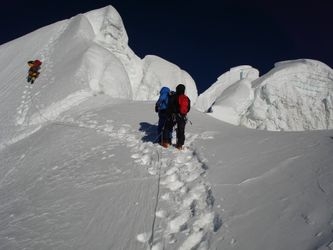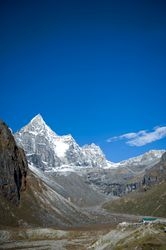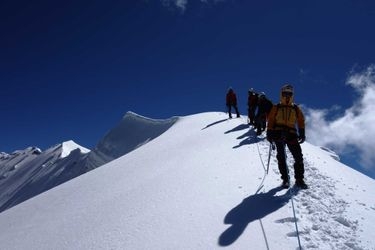Climbing Dhampus Peak
Also known as: Thapa Peak
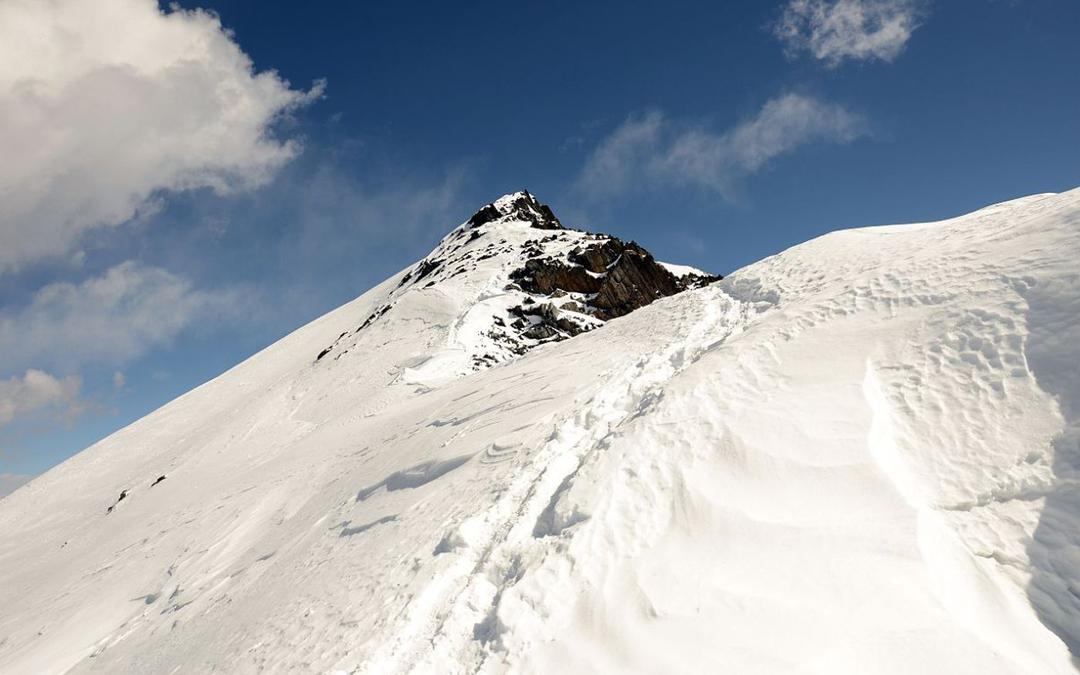
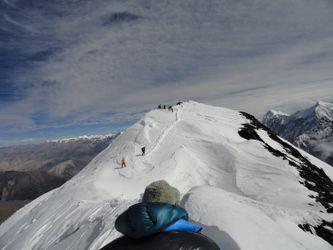

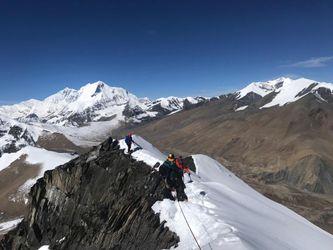

Dhampus Peak, nestled in the heart of the Dhaulagiri range in Nepal, stands at an impressive 6,012 meters above sea level. This peak offers a non-technical climb that attracts seasoned mountaineers looking for a less crowded ascent with rewarding views. The approach to the mountain involves traversing through the magnificent Kali Gandaki valley, offering glimpses of the diverse landscapes of the Annapurna and Dhaulagiri ranges. The climb itself is straightforward, with the main challenge being its altitude. The ascent demands careful acclimatization, but the route does not require advanced technical skills, making it an appealing choice for those who have experience in high-altitude trekking.
The conditions on Dhampus Peak are typical of the Himalayan region, with weather patterns that can change rapidly. Climbers should be prepared for cold temperatures and the possibility of snow, particularly during the early or late parts of the climbing season. The best time to attempt this peak is during the pre-monsoon (April to June) and post-monsoon (September to November) periods when the weather is most stable. The final ascent involves negotiating a snow-covered ridge that offers a panoramic vista of the surrounding peaks, including the towering Dhaulagiri and the distant Annapurnas. This ridge walk is the highlight of the climb, providing a sense of solitude and a connection to the vastness of the Himalayas.
For those considering an expedition to Dhampus Peak, you'll find that the mountain is served by around 30 guides who offer their expertise to help you navigate its slopes. These guides can assist with logistics, ensuring a safe and enriching experience. The mountain’s relatively accessible nature combined with its stunning scenery makes it a worthy addition to any mountaineer's itinerary in Nepal.
Table of contents
Route
- 5,112 m gain over 18 days
- starting in Beni
- ending in Jomsom
- approach: walk in, drive, fly
Walk in
- +4,200 m over a 70 km approach
- 13 days in
- 2 days out
Climb
- +912 m over 1 day.
- 0 high camps.
Difficulty
- PD: Not very hard (alpine grade 2)
When to go
- March to May
- October and November
Permits
- 3 permits are needed
- costing around $150 total
Guide mandatory?
- no
These are pictures taken while climbing Dhampus Peak. They're shown here to give you an idea of what the route is like. You're welcome to share your own pictures of climbing Dhampus Peak, to help the community of climbers. Picture here are either uploaded by members (their own, or creative commons pictures), or guides.
Guide links
Dhampus Peak History
Climbing history of Dhampus Peak
The history of Dhampus Peak is relatively modern compared to some of the more storied mountains in the Himalayas. Located in the Dhaulagiri range of Nepal, Dhampus Peak offers a unique vantage point with its proximity to the Dhaulagiri massif.
Early summit attempts on Dhampus Peak are not well-documented, as the peak was generally overshadowed by the more formidable and well-known Dhaulagiri I. The peak began to gain attention as the trekking routes in the Annapurna and Dhaulagiri regions became more popular with adventurers seeking less crowded paths and easier ascents compared to the higher peaks.
The area around Dhampus Peak is inhabited by the Gurung and Magar communities, known for their rich cultural heritage and traditional lifestyles. These communities have lived in harmony with the rugged terrain for centuries, and their vibrant traditions contribute to the unique cultural experience of trekking in this region.
 Hidden Valley Base Camp
Hidden Valley Base Camp
 Dhampus Peak Summit
Dhampus Peak Summit
Dhampus Peak weather
How is the weather on Dhampus Peak, and when is the best time to go.
The best time to climb Dhampus Peak is in these months:
- Mar
- Apr
- May
- Oct
- Nov
Dhampus Peak Gear Packing List
What To Take to climb Dhampus Peak
Gear:
- Mountaineering Boots
- Crampons
- Ice Axe
- Climbing Harness
- Climbing Helmet
- Trekking Poles
- Rope (with appropriate length)
- Carabiners
- Quickdraws
- Slings
- Ascender/Descender Device
- Belay Device
- Prusik Cord
- Mountaineering Backpack
- Sleeping Bag (appropriate for the season)
- Sleeping Pad/Mattress
- Tent
- Cooking Stove
- Cookware
- Headlamp with Extra Batteries
- Sun Protection (sunglasses, sunscreen, lip balm)
- First Aid Kit
- Personal Medications
- Water Filtration System
- Map and Compass/GPS
- Multi-tool/Knife
- Lightweight Clothing (moisture-wicking base layers, insulating layers, and waterproof shell)
- Warm Hat and Gloves
- Mountaineering Goggles
- Thermal Socks
- Gaiters
- Hand Warmers
- Emergency Shelter
- Portable Altitude Chamber (PAC) or Gamow Bag
- Communication Device (satellite phone or radio)
- Emergency Whistle
- Repair Kit for Gear (duct tape, repair patches)
- Trash Bags (for waste disposal)
- Document Copies (passport, permits, etc.)
Dhampus Peak Services
Gear rental, porters, guides, transport, internet, accommodation
Accommodation
Accommodation options on the Dhampus Peak route include teahouses and basic lodges. These lodgings provide comfortable resting places with shared facilities, offering trekkers a chance to relax and refuel after a day's trekking.Food
Food is readily available at the teahouses and lodges along the route. Expect a variety of local and international dishes, catering to trekkers' preferences and dietary requirements. It's advisable to try local Nepali cuisine and high-energy foods suitable for trekking.Guides
Experienced guides are available for hire to assist trekkers and climbers on the Dhampus Peak route. The cost of hiring a guide can vary depending on their expertise and the duration of the trek. Guides offer valuable insights, ensure safety, and provide cultural context to enrich the journey.Porters
Porters are readily available to help carry heavy loads, allowing trekkers to enjoy the journey with lighter backpacks. Hiring porters can greatly ease the physical burden and make the trek more enjoyable, especially at higher altitudes.Medical facilities
While there are no major medical facilities along the trekking route, some larger villages may have basic medical clinics for minor ailments and injuries. Trekkers are advised to carry personal first aid kits and any necessary medications. In case of serious health issues, immediate evacuation to lower altitudes is necessary.Gear rental
Some gear can be rented in Kathmandu or Pokhara, such as sleeping bags, trekking poles, and down jackets. However, it's advisable to bring personal gear, especially essential climbing equipment like mountaineering boots, crampons, and ice axes. Proper gear is crucial for a safe and successful climb.Transport
To reach the starting point of the trek, trekkers can take a domestic flight from Kathmandu to Pokhara and then travel by road to the trailhead. Alternatively, there are bus services available from Kathmandu to Pokhara. Within the trekking route, transport options are limited to walking.Internet / Phone
Connectivity on the Dhampus Peak route is limited, especially at higher altitudes. Trekkers may find sporadic mobile phone signal in some areas, but it cannot be relied upon for constant communication. Wi-Fi is available in some teahouses, but expect it to be slow and at an additional cost. Trekkers should inform loved ones about limited communication during the trek.ATMs
There are no ATMs along the trekking route. It's best to withdraw enough cash in Kathmandu or Pokhara before starting the journey. Some larger towns like Pokhara may have ATMs where you can withdraw money before heading to the trailhead.Shops
There are shops in villages along the route, offering basic supplies such as snacks, water, toiletries, and occasionally souvenirs. However, the variety of items may be limited and at a higher cost due to the remote location.Dhampus Peak permits
What permits are needed for climbing Dhampus Peak
1. TIMS (Trekkers' Information Management System) Permit
- $20 (~2,000 in the local currency)
- This permit is required for all trekkers in Nepal.
- Can be obtained through a trekking agency or the Nepal Tourism Board in Kathmandu or Pokhara.
2. Annapurna Conservation Area Permit (ACAP)
- $30 (~3,000 in the local currency)
- This permit allows entry into the Annapurna Conservation Area, where Dhampus peak is located.
- Available at the Nepal Tourism Board office in Kathmandu or Pokhara, or at entry checkpoints along the trekking route.
3. Dhampus Peak Climbing Permit
- $100 (~10,000 in the local currency)
- This permit specifically allows climbing Dhampus peak.
- Issued by the Nepal Mountaineering Association (NMA) in Kathmandu or through authorized trekking agencies.
Dhampus Peak access - getting there
How to get to Dhampus Peak
Getting to the Start of Dhampus Peak Climb:
- Option 1: The Dhampus Peak climbing itinerary initiates with a drive from Kathmandu to Pokhara city then to Beni in the west. Trek starts towards Tatopani and progresses to the quaint villages of Ghasa, Larjung and Marpha along the Kali Gandaki river. Trek moves to a higher altitude from Yak Kharka and crosses Dhampus/Thapa Pass before summiting Dhampus Peak.. The road journey from Pokhara to the trailhead offers breathtaking views of the Himalayan landscape.
- Option 2: Overland Journey from Kathmandu to Pokhara: If you prefer a more budget-friendly option, you can opt for an overland journey from Kathmandu to Pokhara by bus. The bus ride takes around 6-7 hours and offers a chance to witness the countryside scenery and the lifestyle of local communities en route to Pokhara. From Pokhara, continue as mentioned in Option 1 to reach the trailhead.
Return from the End of Dhampus Peak Climb:
- Option 1: Trekking Back to Pokhara: After successfully summiting Dhampus Peak and completing the trek, you have the option to trek back to Pokhara following the same route. This return journey allows you to revisit the beautiful landscapes and villages you encountered on your way up.
- Option 2: Overland Transport to Pokhara: If you prefer a more convenient and quicker return, you can arrange for overland transport from the endpoint of the trek to Pokhara. Private jeeps or shared vehicles can be hired to take you back to Pokhara, where you can relax and celebrate your accomplishment.
- Option 3: Alternate Trekking Route or Further Exploration: For those seeking more adventure, you can choose an alternate trekking route to explore the Annapurna region further. There are several trails that lead to different destinations, allowing you to extend your journey and experience more of Nepal's natural beauty.
These are variations on the typical route. Which could be added on; either part way along or at the start / end to extend the trek.
Tilicho Lake Trek
add 4 extra days
Dhampus Peak questions
What to know about climbing Dhampus Peak
Common questions people have about this trek, if yours isn’t here - add it to get an answer.
Dhampus Peak Links
useful websites, Groups and communities
Groups / links with more info on the Dhampus Peak route.
These climbs are similar in length, difficulty, and elevation. Offering a similar level of challenge as the Dhampus Peak climb.

